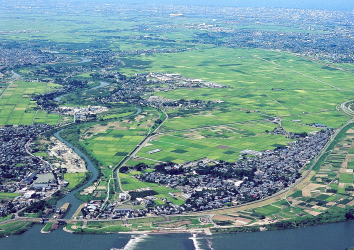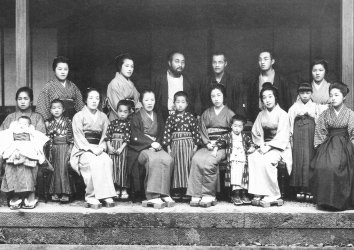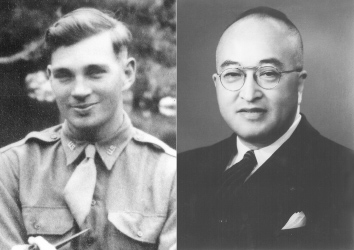The history of the Ito family begins in 1746.
In 1746, Bunkichi the first, then aged 20, founded his own, separate branch of the family. He was given approx. 3,000㎡ of agricultural land – an area about the same size as that of the ground in the Tokyo Dome Stadium – and moved into a house with two six-tatami-mat rooms and a kitchen. Shortly afterwards he married Kiyo, the daughter of a dyer, and went into the indigo trade alongside farming.
In 1801, Bunkichi’s son Yasujiro inherited his father’s name to become Bunkichi the second at the age of 35. This second Bunkichi was permitted to take a surname and wear a sword in 1837. He decided to call himself Bunkichi Ito. At about the same time, trading under the company name of “Iwano-ya,” he expanded the business to include cereals, pawnbroker and warehousing as well as indigo. He gave up farming and became the richest merchant in the region.
Bunkichi adopted Tamejiro, the son of his second wife’s previous husband, and Tamejiro, now the third Bunkichi, became the founder of the Ito family line. However Saroku, who should have become the fourth Bunkichi, died when he was only 44 years old. It was therefore the third Bunkichi’s grandson, Younosuke, who succeeded to the family name, becoming the fifth Bunkichi when he was only sixteen.

Aerial Photograph (taken above Soumi in Konan Ward, Niigata City)
Soumi is an area with longstanding ties to the Ito family.
In the foreground is the Agano River, the great river which is the pride of Niigata. Above meanders the smaller Koagano River. Soumi is the long, narrow village sandwiched in between. For 77 years, starting in 1610, here was a house where a Japanese feudal lord lived known as Soumi Castle, and Soumi prospered as a modest castle town of 14,000 Koku rice yields, about 1,650t. Thereafter Soumi came under shogunate control. A magistrate’s office was set up, after which Soumi became the territory of Ohama, direct retainer of the shogun. At the start of the Meiji Period, in 1869, when the land and people were returned from the feudal lords to the Emperor, the samurai society came to an end ushering in the period in which the Ito family rose to prominence.
Ito Residence – completed in 1889, after eight years of building work
The Edo Period gave way to the Meiji (1868-1912). In 1882, the fifth Bunkichi began to construct a new Ito residence on an approx. 18,000㎡ plot of land. Building materials were bought and brought down from as far afield as Aizu, Yamagata and Akita and eight years later, in 1889, the present Ito Residence was finished.
Kenjiro, who became the sixth Bunkichi, displayed extraordinary ability as a rich merchant. In 1892, when he married a bride from the noble Murayama family, the magnificent wedding banquet lasted three days and nights. Though Bunkichi continued steadily to expand the family’s domain, he died in 1903, when he was 33.
At only eight years old, his second son, Atsuo, became the seventh Bunkichi and head of the household. With the support of the family the young Bunkichi readily assumed his role as a landowner and acquired more land. By 1924, the estate covered 1,346hectares (equivalent to the area of 300 Tokyo Domes!), and 60 servants and retainers of the Ito family lived in the family house premises.
The Meiji Period was followed by the Taisho (1912-1926). After graduating from Keio University, the seventh Bunkichi went to the United States to continue his studies at Pennsylvania University. His son, Yoshihiko, the future eighth Bunkichi, was born shortly after his return in 1927.

First Anniversary of the Sixth Bunkichi’s Death – commemorative photograph of the Ito Family
June, 1904. In the middle you can see the seventh head of the family when he was still a young boy.
On the left is Kii, his grandmother, and on the right is his mother, Masago. Kii was a member of the Oshiki family from the nearby former village of Chinoyama and came as a bride to the Ito family when she was thirteen years old. She bore at least ten children. After the death of her husband, the fifth head of the family, and despite being a woman, she held the reins of power in the household for many years and under her management the estate grew to cover nearly 1000 hectares. Masago belonged to the noble Murayama family from the former town of Takayanagi-machi. This was an old family of higher social status than the Ito family at that time. She married when she was sixteen. After the death of her husband, the sixth Bunkichi, she looked after the family with the help of her mother-in-law, Kii.
The well-built gentleman at the back is Kurota Ito who acted as the guardian of the seventh Bunkichi until the latter came of age. Kurota was the younger brother of the sixth Bunkichi. Later he formed a separate branch of the Ito family in Minamihama where he became the head of the new household. The Ito house from that time in Minamihama is now the Niigata branch of the Northern Culture Museum.












